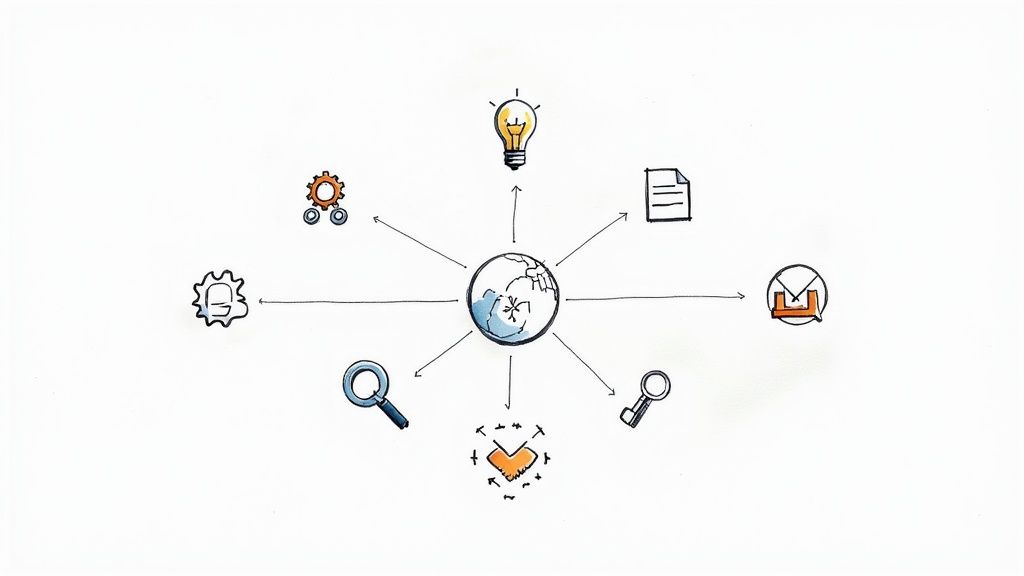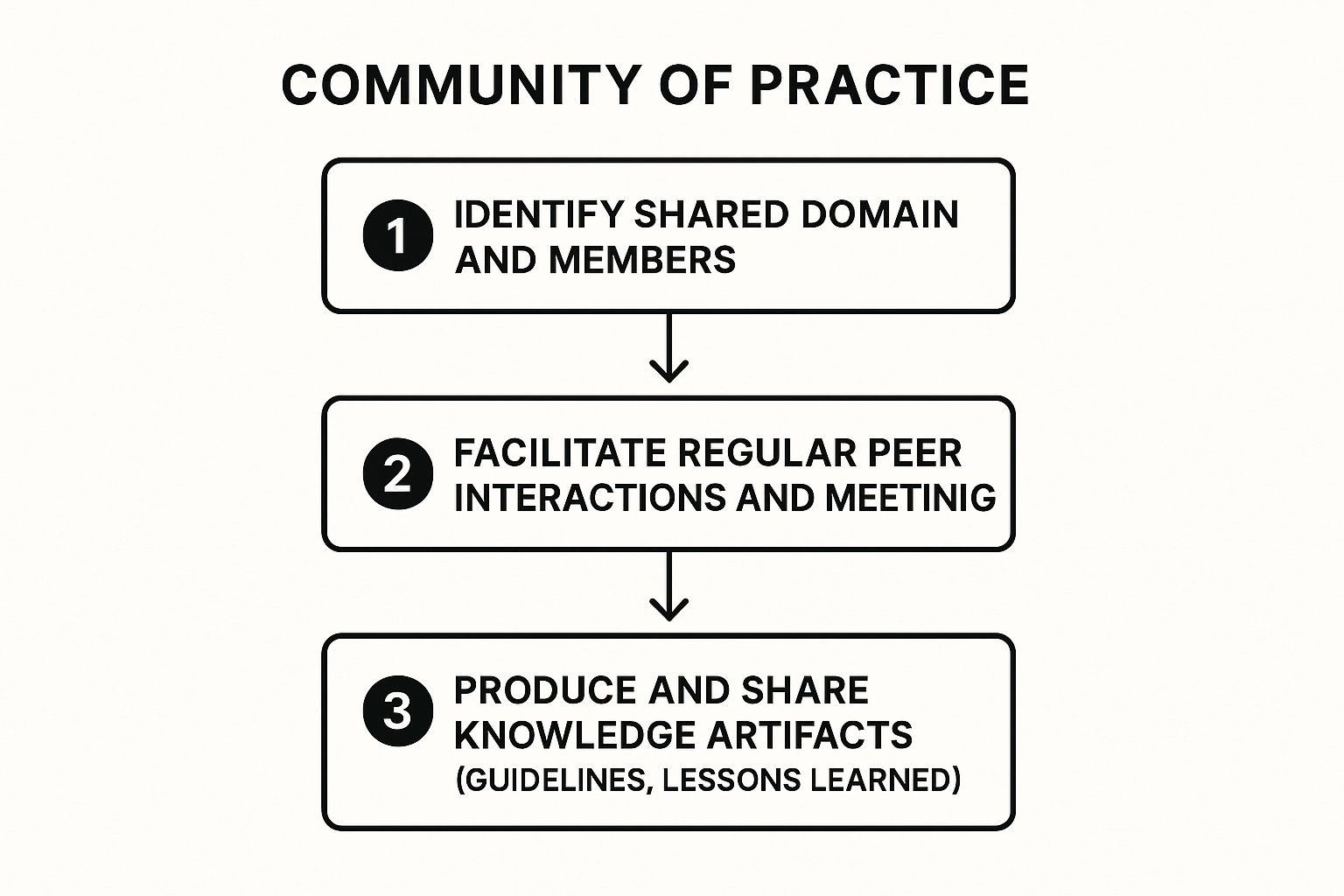9 Essential Knowledge Management Best Practices for 2025

In today’s fast-paced business environment, what an organization knows is its greatest competitive advantage. Yet, this critical asset is often scattered across different platforms, siloed within departments, or lost entirely when an expert walks out the door. Effective knowledge management isn’t just about storing documents; it’s a strategic discipline for capturing, sharing, and leveraging collective wisdom to drive innovation, improve efficiency, and accelerate growth.
Moving from chaotic information streams to a cohesive intelligence ecosystem requires more than just new software, it demands a deliberate strategy. This guide unpacks nine proven knowledge management best practices, offering a detailed roadmap to transform how your organization learns, adapts, and succeeds. We will explore actionable strategies, from fostering a collaborative sharing culture and implementing a centralized repository to leveraging AI and measuring the real-world impact of your efforts.
The goal is to provide a framework that helps you build a system that not only preserves institutional knowledge but actively puts it to work in your daily operations. Each practice is designed to be a practical building block for a more resilient and intelligent organization. For an additional, comprehensive look at essential strategies, explore the Top 9 Best Practices for Knowledge Management in 2025. By implementing these approaches, you can ensure your team has the information it needs, precisely when it’s needed, turning scattered data into a powerful, accessible asset.
1. Create a Knowledge-Sharing Culture
At its core, knowledge management isn’t about software or databases; it’s about people and their willingness to share what they know. One of the most critical knowledge management best practices is to cultivate a culture where sharing information is a natural, valued, and rewarded part of daily work. This involves a fundamental shift from information hoarding to fostering collective intelligence. It requires moving beyond just implementing tools and focusing on changing mindsets and behaviors across the organization.
An environment that prioritizes psychological safety, where employees feel comfortable sharing ideas, asking questions, and even discussing failures without fear of reprisal, is the bedrock of a knowledge-sharing culture. It’s about building trust and dismantling the silos that prevent information from flowing freely between teams and departments.

Real-World Examples
Several innovative companies have mastered this cultural shift. Toyota’s ‘ba’ concept, for instance, creates physical, virtual, and mental spaces where employees can interact and create new knowledge together. Similarly, NASA implements rigorous “pause-and-learn” sessions after missions, creating a structured process to capture and disseminate lessons learned, ensuring past experiences inform future success. Under Satya Nadella, Microsoft transformed its notoriously competitive internal culture into a collaborative “growth mindset,” encouraging continuous learning and sharing.
Actionable Implementation Tips
Building this type of culture is an intentional process. Here are specific steps you can take:
- Secure Leadership Buy-In: Change starts at the top. When leaders actively participate in knowledge-sharing initiatives, it sends a powerful message about its importance.
- Celebrate Successes: Actively recognize and reward employees who contribute valuable knowledge. Publicize their contributions in team meetings or company newsletters to create role models.
- Integrate into Workflows: Don’t make knowledge sharing an extra task. Weave it into existing processes, such as adding a “lessons learned” section to project debriefs or using collaborative productivity tools for freelancers and teams that make sharing seamless.
- Address “What’s in it for me?”: Clearly communicate how sharing knowledge benefits individuals directly, whether through career growth, recognition, or making their own work easier.
2. Implement a Centralized Knowledge Repository
Once a culture of sharing is in motion, the next logical step in establishing effective knowledge management best practices is to give that knowledge a home. A centralized knowledge repository is a unified digital platform where organizational documents, procedures, best practices, and expertise are stored, organized, and made easily accessible. It consolidates information scattered across emails, personal drives, and various apps into a single, searchable “source of truth,” preventing knowledge loss and reducing the time employees spend searching for information.
This practice moves beyond simple file storage. It involves creating a structured, living library of institutional wisdom that empowers employees with the information they need, precisely when they need it. To effectively manage organizational knowledge, consider establishing a robust centralized knowledge repository to serve as the backbone of your information architecture.

Real-World Examples
The impact of a well-executed repository is significant. Airbnb developed an internal knowledge base that successfully reduced support ticket volume by 20% by empowering agents with instant answers. Deloitte’s global knowledge management system serves over 100,000 professionals, providing them with access to case studies, industry research, and internal expertise worldwide. Similarly, the World Bank utilizes an extensive repository to support complex development projects across more than 180 countries, ensuring lessons from one project inform others.
Actionable Implementation Tips
Creating a successful repository requires thoughtful strategy, not just technology. Here are key steps to get started:
- Start Small and Scale: Don’t attempt to migrate everything at once. Begin with high-value, high-demand content areas, like sales playbooks or engineering best practices, to demonstrate immediate value.
- Involve End-Users: Collaborate with the people who will use the repository to design its taxonomy and navigation. A user-centric structure is crucial for adoption.
- Assign Content Owners: Designate specific individuals or teams as owners for different knowledge areas. This ensures accountability for keeping content accurate, relevant, and up-to-date.
- Establish a Content Lifecycle: Implement policies for regular content review and archiving. Not all knowledge is evergreen; setting expiration dates prevents the repository from becoming a digital junkyard.
3. Capture Tacit Knowledge Through Documentation and Storytelling
A significant portion of an organization’s most valuable knowledge isn’t stored in databases; it resides in the minds of its experienced employees. This is tacit knowledge: the intuitive know-how, judgment, and expertise gained through years of hands-on experience. A crucial knowledge management best practice is to systematically capture this expertise and convert it into explicit, shareable assets. This process goes beyond writing simple manuals; it involves documenting the context, the reasoning, and the stories behind decisions and actions.
Failing to capture tacit knowledge creates a massive organizational risk. When a key expert retires or leaves the company, their unique insights and problem-solving abilities walk out the door with them. Effective knowledge capture ensures this critical intelligence is preserved, scaled, and made available to current and future employees, preventing the organization from constantly reinventing the wheel and repeating past mistakes.
Real-World Examples
Many forward-thinking organizations have built robust systems for this. The U.S. Army’s Center for Army Lessons Learned (CALL) is a world-class example, systematically debriefing soldiers after operations to document what worked, what didn’t, and why, turning battlefield experience into institutional wisdom. Similarly, Xerox’s Eureka project created a database where technicians could share unique repair tips and stories, significantly improving first-call fix rates. Chevron also famously saved an estimated $30 million by capturing and sharing a single best practice related to oil well management.
Actionable Implementation Tips
Capturing tacit knowledge requires a deliberate and structured approach. Here are specific steps you can implement:
- Conduct Proactive Knowledge Capture Sessions: Don’t wait until an expert’s last day. Schedule structured interviews or “brain dump” sessions well before they retire or transition to a new role.
- Use Skilled Facilitators: The person conducting the interview should be trained in knowledge elicitation techniques, knowing how to ask probing questions that uncover underlying assumptions and decision-making processes.
- Embrace Storytelling: Encourage experts to share “war stories,” including failures and unexpected solutions. Narratives are a powerful vehicle for conveying complex, context-rich information that a simple checklist cannot.
- Focus on the “Why”: The goal isn’t just to document the steps of a process but to understand the reasoning and judgment behind each step. Ask questions like, “What were you thinking at that moment?” or “What alternatives did you consider?”
- Make Knowledge Discoverable: Use a centralized system with robust search capabilities to store the captured information. Tag content with relevant keywords to ensure it can be found easily when needed.
4. Leverage Technology and AI for Knowledge Management
While culture is the heart of knowledge management, technology is the nervous system that enables information to travel quickly and intelligently. A crucial knowledge management best practice is to strategically deploy modern technologies, especially artificial intelligence (AI), to supercharge how knowledge is captured, organized, discovered, and delivered. This moves beyond static, folder-based repositories and creates a dynamic, intelligent ecosystem that actively helps users find what they need, often before they even ask.
This approach transforms your knowledge base into a living system that learns from user interactions, automates tedious categorization, and can even surface hidden insights from vast amounts of unstructured data like emails, chat logs, and documents. By integrating AI, you make knowledge not just stored, but truly accessible and actionable at the moment of need.

Real-World Examples
Leading companies are already harnessing AI to revolutionize their knowledge management. JPMorgan Chase’s COiN platform uses machine learning to analyze complex legal contracts in seconds, a task that once took lawyers thousands of hours. Similarly, Salesforce Einstein AI proactively suggests relevant knowledge articles to service agents during customer calls, dramatically reducing resolution times. Unilever also uses an AI-powered knowledge platform to connect its global R&D teams, accelerating product development cycles by helping them find relevant research and avoid duplicating work.
Actionable Implementation Tips
Effectively leveraging technology requires a strategic, not a “tool-first,” approach. Here are specific steps to get started:
- Start with Clear Use Cases: Instead of buying AI for its own sake, identify specific problems it can solve. Do you need faster customer support responses? Better R&D collaboration? Define the goal first.
- Prioritize Data Quality: AI is only as good as the data it’s trained on. Before deployment, focus on cleaning and structuring your existing knowledge assets to ensure the AI can learn effectively.
- Combine AI with Human Oversight: Use AI to augment, not replace, human expertise. Implement feedback loops where employees can validate or correct AI-generated summaries and recommendations, which helps the system improve over time.
- Focus on the User Experience: The best technology is invisible. Choose tools with intuitive, user-friendly interfaces that integrate seamlessly into existing workflows.
5. Establish Communities of Practice
While formal structures manage explicit knowledge, much of an organization’s most valuable expertise exists within the tacit, informal networks between people. One of the most effective knowledge management best practices is to formalize these networks by establishing Communities of Practice (CoPs). Coined by learning theorists Jean Lave and Etienne Wenger, CoPs are groups of people bound by a shared passion or professional craft who come together to deepen their collective knowledge. They are the living, breathing libraries of an organization’s practical wisdom.
These communities create a powerful bridge between formal training and on-the-job reality. By connecting practitioners across different teams, departments, or even geographical locations, CoPs accelerate problem-solving, spark innovation, and codify best practices that might otherwise remain siloed within a single team. They provide a space for peer-to-peer learning that is both relevant and immediately applicable.
The following process flow visualizes the foundational steps for launching a successful community.

Following this simple sequence ensures that a community is built on a solid foundation of shared interest and produces tangible value for its members and the organization.
Real-World Examples
The impact of CoPs is well-documented across industries. Xerox famously saved over $100 million by supporting a community of technicians who shared repair tips and solutions in the field, far beyond what official manuals could provide. The World Bank uses Thematic Groups to connect development experts globally, enabling them to share project insights and improve aid effectiveness. Similarly, McKinsey & Company relies on its extensive network of practices to connect consultants across offices, ensuring a new consultant in Dubai can access the expertise of a senior partner in New York.
Actionable Implementation Tips
Successfully nurturing CoPs requires a delicate balance of support and autonomy. Here are key steps to get started:
- Provide Support, Not Control: Offer resources like a dedicated communication channel (e.g., a Slack channel or forum) and a small budget, but let the community define its own agenda and goals.
- Identify and Empower Coordinators: Find passionate individuals willing to act as community leaders or facilitators. Their role is to spark conversations, organize events, and maintain momentum.
- Start with a Real Problem: Launch a CoP around a pressing business challenge or a genuine shared interest. An authentic purpose is far more compelling than a top-down mandate.
- Mix Online and In-Person Interactions: While digital platforms are essential for day-to-day connection, periodic face-to-face meetups can significantly strengthen relationships and trust within the group.
6. Integrate Knowledge Management into Daily Workflows
For knowledge management to be truly effective, it cannot be an afterthought or a separate, burdensome task. One of the most impactful knowledge management best practices is to embed the capture, sharing, and retrieval of information directly into the daily workflows employees already use. This approach makes knowledge management invisible and frictionless, transforming it from a chore into a natural byproduct of getting work done. The goal is to meet people where they are, integrating KM into the tools and processes they rely on every day.
When knowledge sharing is woven into the fabric of daily operations, it eliminates the friction of switching contexts or performing extra steps. This integration ensures that valuable insights are captured in real-time and knowledge is delivered precisely when and where it is needed. This fundamentally shifts KM from a passive repository to an active, dynamic asset that enhances productivity and decision-making.
Real-World Examples
Leading tech companies excel at this integration. Salesforce embeds its knowledge base directly into the service agent’s console, allowing them to find and attach relevant articles to support tickets without leaving their main screen. GitLab has a “handbook-first” approach, where documenting processes and decisions within their central handbook is a required part of the development workflow itself. Similarly, Microsoft Teams integrates document co-authoring, wikis, and file sharing directly within project channels, making collaboration and knowledge capture a single, seamless activity.
Actionable Implementation Tips
To effectively integrate KM into your workflows, focus on reducing friction and adding value. Here are specific steps to take:
- Map Existing Workflows: Before introducing new tools, analyze and understand your team’s current processes to identify the most logical and high-impact points for KM integration.
- Keep Capture Simple: Design mechanisms that are non-disruptive. For example, use project closure templates in tools like Monday.com that include a mandatory “lessons learned” section.
- Deliver Knowledge Contextually: Use triggers within your workflows to push relevant information to users. A new sales lead, for instance, could automatically trigger a notification with links to relevant case studies.
- Leverage workflow automation: Automate the process of capturing and routing information to the right places, reducing the manual effort required from employees.
- Start Small and Iterate: Begin with one or two high-impact workflows, such as customer support or project management. Test the integration with users, gather feedback, and optimize before a wider rollout.
7. Implement Robust Knowledge Governance and Quality Control
While creating and sharing knowledge is vital, its value diminishes rapidly if it’s inaccurate, outdated, or impossible to find. Implementing robust governance is one of the most critical knowledge management best practices for ensuring the long-term health and trustworthiness of your knowledge base. Governance establishes the rules of the road: the policies, roles, and standards that keep organizational knowledge accurate, relevant, secure, and compliant.
This framework defines who owns specific knowledge assets, who can access them, how they should be tagged and organized, and when they need to be reviewed or retired. Far from being bureaucratic red tape, good governance is the quality control system that prevents your knowledge repository from devolving into a chaotic, unreliable “digital junkyard” that users eventually abandon. It balances necessary control with the flexibility needed to encourage widespread participation.
Real-World Examples
Governance is a core function in highly regulated and information-sensitive industries. Pharmaceutical companies use strict validation protocols to ensure every piece of scientific data is accurate and traceable. Banking institutions build compliance-driven governance into their systems to manage regulatory knowledge and mitigate risk. Even open platforms like Wikipedia thrive on a sophisticated governance model, with editorial policies, administrator roles, and community-driven quality control to maintain credibility.
Actionable Implementation Tips
Effective governance should enable, not hinder, knowledge sharing. Here’s how to implement it practically:
- Establish Clear Ownership: Assign specific “knowledge stewards” or owners to different content areas. These individuals are responsible for reviewing, updating, and validating information within their domain.
- Create Content Lifecycles: Define a process for content from creation to archival. Use automated reminders for periodic reviews and set clear criteria for when information should be retired.
- Develop Simple Standards: Create easy-to-follow templates and style guides for new knowledge submissions. This ensures consistency and makes information easier to consume.
- Differentiate Based on Criticality: Apply stricter governance to high-stakes information (like compliance procedures) and more lenient rules for less critical content (like team brainstorming notes). This “right-sized” approach prevents unnecessary friction.
8. Measure Knowledge Management Effectiveness and ROI
If you can’t measure it, you can’t improve it. This adage is especially true for knowledge management, where demonstrating tangible value is crucial for sustained investment and engagement. One of the most vital knowledge management best practices is to systematically measure the effectiveness and return on investment (ROI) of your initiatives. This moves KM from a “nice-to-have” function to a strategic business driver.
Measuring effectiveness means going beyond simple activity metrics like the number of articles created. It involves connecting KM activities to concrete business outcomes such as reduced costs, increased efficiency, improved innovation, and better customer satisfaction. It’s about answering the critical question: “How is our investment in knowledge management making our organization better?”
Real-World Examples
Several industry leaders have successfully quantified the impact of their KM programs. Schlumberger, the oilfield services giant, used its knowledge-sharing platform to achieve a 98% reduction in the time it took engineers to find critical information. Texas Instruments calculated a staggering $1.5 billion in savings by fostering knowledge reuse and collaboration among its engineers. Similarly, Ford Motor Company documented over 1,300 best practices that collectively saved the company more than $850 million, showcasing a direct link between knowledge sharing and financial performance.
Actionable Implementation Tips
To effectively measure your KM efforts, you need a clear and strategic approach. Here are specific steps you can take:
- Align Metrics with Business Goals: Don’t measure in a vacuum. Connect your KM metrics directly to overarching strategic objectives, whether it’s reducing customer support resolution times or accelerating product development.
- Use a Balanced Scorecard: Combine different types of metrics. Use leading indicators (e.g., system adoption rates, number of contributions) to track progress and lagging indicators (e.g., cost savings, employee retention) to measure ultimate impact.
- Establish a Baseline: Before launching a new KM initiative, collect baseline data. This allows you to accurately demonstrate improvement and calculate ROI over time.
- Communicate in Stakeholder Language: Present your findings in terms that leadership understands and cares about: money saved, time reduced, quality improved, and risks mitigated. Use qualitative success stories alongside quantitative data to create a compelling narrative.
9. Ensure Executive Sponsorship and Strategic Alignment
Knowledge management initiatives often fail not from a lack of tools or effort, but from a lack of visible, active support from the top. Securing executive sponsorship is one of the most vital knowledge management best practices because it transforms a departmental project into a strategic organizational priority. It’s about more than just getting a budget approved; it’s about aligning KM goals directly with the company’s core business objectives, ensuring the initiative is seen as essential for success.
When leaders champion knowledge management, it legitimizes the effort, removes organizational barriers, and motivates employees to participate. This alignment ensures that KM activities are not just busywork but are directly contributing to solving critical business problems, such as accelerating innovation, improving customer satisfaction, or increasing operational efficiency. Without this strategic connection, KM can quickly become an isolated, underfunded program with little impact.
Real-World Examples
Executive-led transformation is a recurring theme in successful KM. Under Satya Nadella, Microsoft’s cultural shift toward a “growth mindset” was a top-down initiative that directly fueled knowledge sharing. Similarly, Siemens found massive success with its ShareNet program, which had explicit, ongoing sponsorship from the executive board. Another powerful example is the Ritz-Carlton Hotel Company, where executive commitment to service excellence created a culture where sharing knowledge about guest preferences is a core operational value, not just a secondary task.
Actionable Implementation Tips
Gaining and maintaining executive support requires a strategic approach. Here are specific steps to take:
- Speak Their Language: Frame KM benefits in business terms like ROI, risk reduction, or market share growth. Avoid jargon and focus on how KM solves problems that keep executives up at night.
- Align with Priorities: Identify a key strategic goal, like improving product innovation, and launch a pilot KM project that directly supports it. Quick, visible wins build momentum and credibility.
- Provide Regular Updates: Keep sponsors engaged with concise briefings that use data and metrics to demonstrate how knowledge management is impacting strategic objectives.
- Make It Visible: Ask your executive sponsor to communicate the importance of KM in company-wide meetings or internal communications. Their voice carries far more weight than a project manager’s.
Knowledge Management Best Practices Comparison
| Practice | Implementation Complexity 🔄 | Resource Requirements ⚡ | Expected Outcomes 📊 | Ideal Use Cases 💡 | Key Advantages ⭐ |
|---|---|---|---|---|---|
| Create a Knowledge-Sharing Culture | High – cultural change over 6-24 months | Significant leadership & ongoing effort | Enhanced innovation, reduced duplication, stronger engagement | Organizations seeking long-term cultural transformation | Builds resilience, fosters trust, boosts engagement |
| Implement a Centralized Knowledge Repository | Medium-High – migration and curation needed | IT infrastructure and ongoing maintenance | Faster access to accurate info, knowledge retention, self-service | Firms needing consolidated info access and audit readiness | Single source of truth, reduces search time, supports compliance |
| Capture Tacit Knowledge Through Documentation | Medium – time-intensive, expert dependent | Skilled facilitators & time investment | Preserved expertise, contextual insight, faster onboarding | Organizations facing expert turnover or complex knowledge | Captures nuanced know-how, builds organizational memory |
| Leverage Technology and AI for Knowledge Mgmt | High – tech integration and AI training | High upfront tech and data preparation costs | Improved findability, personalized delivery, proactive insights | Enterprises managing large, complex knowledge bases | Scales KM, uncovers hidden patterns, automates processes |
| Establish Communities of Practice | Medium – facilitates informal networks | Moderate support and facilitation resources | Cross-functional collaboration, rapid problem-solving, identity building | Organizations valuing peer learning and innovation | Breaks silos, spreads best practices, boosts engagement |
| Integrate KM into Daily Workflows | Medium-High – integration across tools | Integration specialists, process redesign | Higher KM participation, timely knowledge capture, better adoption | Work environments needing seamless KM in operations | Reduces friction, embeds KM naturally, improves quality |
| Implement Knowledge Governance and Quality Control | Medium-High – policy, roles, enforcement | Ongoing oversight, roles for stewards | Trusted, compliant, organized knowledge, reduced risk | Regulated industries or large orgs requiring quality control | Ensures accuracy, compliance, accountability |
| Measure KM Effectiveness and ROI | Medium – metric design & data analytics | Analytics tools, data collection, expertise | Justifies KM investments, guides improvement, shows business impact | Organizations aiming to prove and optimize KM value | Evidence-based decision making, accountability, continuous improvement |
| Ensure Executive Sponsorship and Strategic Alignment | Medium – leadership engagement and alignment | Leadership time and sponsorship effort | Accelerated adoption, sustained KM initiatives, strategic impact | Enterprises focused on strategic KM success | Provides legitimacy, resources, and cross-functional influence |
Activating Your Knowledge Ecosystem for Lasting Impact
Embarking on a knowledge management initiative can feel like a monumental task, but the journey from disorganized information to a thriving knowledge ecosystem is built one practice at a time. Throughout this guide, we’ve explored the essential pillars that support a truly intelligent organization. From fostering a culture where sharing is second nature to implementing the technological backbone of a centralized repository, each best practice serves a distinct, critical function.
We’ve seen how capturing elusive tacit knowledge through storytelling and mentorship transforms individual expertise into a collective asset. We’ve also detailed how establishing dedicated Communities of Practice creates vibrant hubs for innovation and problem-solving, moving knowledge from a static resource to a dynamic, living entity. The key is not to view these nine principles as a checklist to be completed, but as interconnected components of a holistic strategy.
A robust governance model ensures your knowledge base remains trustworthy and relevant, while consistent measurement proves its value and guides future improvements. Most importantly, securing executive sponsorship ensures that these efforts are not just a departmental project but a strategic priority aligned with core business objectives. The true power of these knowledge management best practices is unleashed when they are woven together, creating a self-reinforcing cycle of learning, sharing, and growth.
From Theory to Tangible Results
The transition from understanding these concepts to implementing them is where the real work begins. The goal is to make knowledge management an invisible, seamless part of everyday operations. When capturing insights is as natural as sending an email, or finding an answer is faster than asking a colleague, you’ve achieved genuine integration.
This integration doesn’t happen by decree; it happens by design. It requires embedding knowledge-centric actions directly into the tools and workflows your team already uses. Think about the friction points in your current processes: Where does information get lost? Where do repetitive questions create bottlenecks? These are your prime opportunities for targeted improvement.
Start by focusing on a single, high-impact area. For instance:
- For a sales team: Begin by standardizing the capture of competitive intelligence and customer objections after sales calls.
- For a support team: Focus on creating a system to turn solved tickets into reusable knowledge base articles.
- For a startup founder: Automate the summarization of investor meetings and strategic sessions to build an institutional memory from day one.
By choosing a specific pain point and applying one or two of these best practices, you can demonstrate immediate value and build the momentum needed for broader adoption. This iterative approach makes the entire endeavor more manageable and ensures that each step forward delivers a tangible return on investment.
Your Next Step: Sustainable Knowledge Flow
Ultimately, a successful knowledge management strategy transforms your organization into a resilient, adaptive entity. It empowers individuals with the information they need to excel, accelerates onboarding, reduces redundant work, and fuels a culture of continuous improvement. You’re not just organizing files; you’re building a collective intelligence that becomes your most significant competitive advantage.
The path forward is one of persistence and strategic refinement. Continuously solicit feedback, celebrate knowledge-sharing champions, and adapt your tools and processes as your organization evolves. By committing to these knowledge management best practices, you are laying the foundation for an organization that doesn’t just navigate change but thrives on it, ready to meet any future challenge with confidence and clarity.
Ready to eliminate the manual work from knowledge capture and build your knowledge base automatically? Sagekit connects to your daily tools and uses AI to summarize meetings, extract action items, and intelligently route insights to the right place. Transform your team’s conversations into a strategic asset by visiting Sagekit to see how you can automate your knowledge flow today.